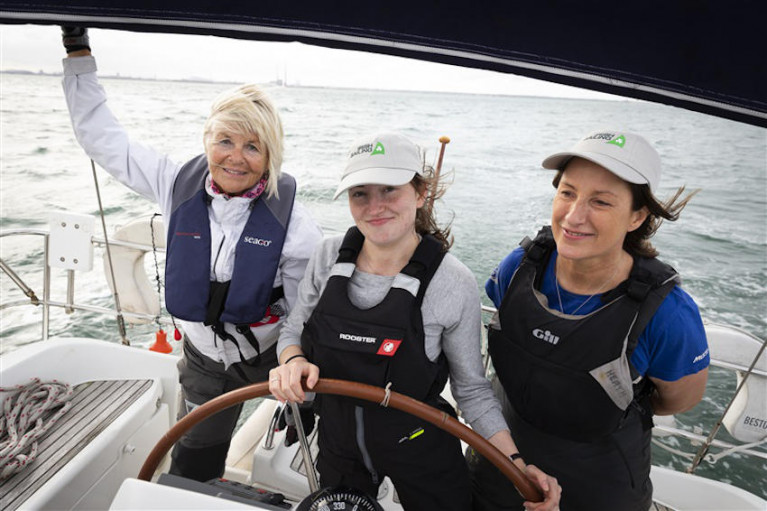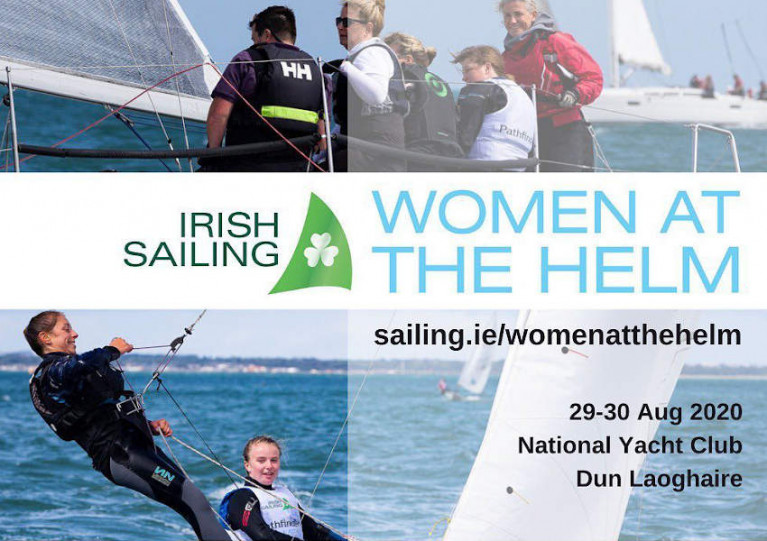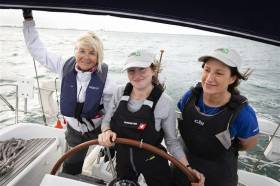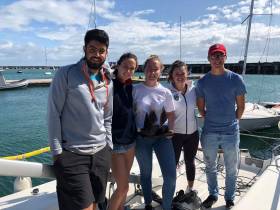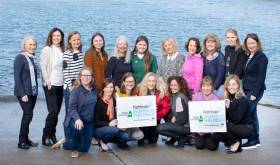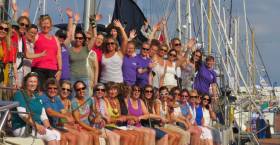Displaying items by tag: Women at the Helm
RS21 Irish Debut with New Female Racers for the Women at the Helm Regatta
Irish National Sailing & Powerboat School Instructor Ciara Moore joined colleagues onboard the RS21 for the recent Irish Sailing Women At Helm Regatta.
The team was led by Irish National Marine Services RS Sailing Rep Heather Wright and sailed on board the RS21, RS Sailing’s modern keelboat designed with corinthian racing at its heart.
It was a new experience for Ciara in more than one way, having not competed in competitive event racing as well as having to master the RS21 with the rest of her crew. Ciara is exactly the type of sailor that Irish Sailing’s event facilitates becoming more involved in a new aspect of the sport and shared here experience of the RS21 and the event.
“As well as learning a new boat, the social aspect meant bonding between people who hadn’t really spoken before. Thanks to Heather's enthusiasm and encouragement, the school entered a 1720 and RS21 in the event. It was such an incredible opportunity to see the other side of the sport, having been heavily involved in teaching. I can imagine it is the same for all the other women competing who maybe haven’t given it a go before or have been doing it for years with a primarily male team.
The varying conditions over the two days meant that both moderate speed and almost no movement were encountered. However, seeing the amount of women on the water from all levels of experience was inspiring. The variety of ages and boat classes and different clubs made it even more significant. It is so important to bring more and more female crew onto racing teams so they have the same chance to participate in regattas and learn on the go. I encourage anyone to take part during the coming years as I certainly will be!”
 RS21 racing in the women at the helm regatta
RS21 racing in the women at the helm regatta
Heather Wright spearheaded the school’s initiative to get young female instructors racing as well as securing the RS21 in time for the event, including a few late night rigging sessions to get the boat prepared, tuned and splashed in time for the event. This combined Heather’s previous experience as Junior Co-ordinator at the school with her current day job as Irish National Marine Services RS Sailing lead.
“Overall we managed to get 19 young female sailors who had never raced before out on the water giving them an opportunity that wasn't there when I was their age. We couldn’t be prouder of the girls and their commitment to the team, Well done ladies.”
The RS21 is now back out of the water and will be back afloat for demo events and test sails over the winter. Prior to the winter DBSC series, the RS21 will be heading to the World Championships in Croatia where RS Sailing are laying on a charter fleet. We cant wait to see where this new venture takes us and the development of the RS21 fleet in Ireland.
Howth Women Take Helm To National Success
In a weekend in which Eve McMahon of Howth added a major Silver Medal to her year's store of internationally-achieved significant metalware, you'd think that was enough to be going on with. But the formidable female skippers of the peninsula were only getting going.
 Racing at the Women at the Helm Regatta on Dublin Bay Photo: Ronan Beirne
Racing at the Women at the Helm Regatta on Dublin Bay Photo: Ronan Beirne
Even as the good news from Portugal was still registering, Eve's clubmates were making hay in the Women at the Helm event across Dubin Bay at the National Yacht Club, with Laura Dillon backed up by Diana Kissane winning overall in Class 1 in charge of the J/99 Snapshot, while Aoife Hopkins won the Sportsboat Division racing one of the HYC J/80s.
 The Class One J122 Aurelia Women at the Helm crew on the dock
The Class One J122 Aurelia Women at the Helm crew on the dock
Women at the Helm Results 2022:
Star-Studded Line-Up for ‘Women at the Helm’ Regatta This Week
The Women at the Helm regatta returns to the National Yacht Club in Dun Laoghaire on Wednesday 24 August and this weekend 27-28 August for its third edition.
And among the nearly 200 experienced women sailors expected to take part are Olympic silver medallist Annalise Murphy; her mother and fellow Olympian, Cathy MacAleavey; international champion Laura Dillon; and rising star Aoife Hopkins.
The Women at the Helm regatta encourages women into positions of leadership. For some it may be a move from crew to helm, or first-time entry into a national event.
For 2022, organisers are expecting more than 50 boats — all helmed by experienced women sailors from around the country, as highlighted previously by our own WM Nixon.
Women at the Helm is open to keelboats, and all ages from teens to seniors. Everyone can enter but a woman must helm and 50% of the crew must be women.
Sixty-nine per cent of those surveyed after the first event said their leadership skills had benefitted as result of taking part in the event, organisers say.
The 2022 event will see racing split over three days starting with the Water Wag class on Wednesday, followed by the rest of the classes at the weekend.
Among the Wednesday-evening Water Wag competitors are 2016 Rio Olympic silver medallist Annalise Murphy (crew) up against her mother Cathy MacAleavey, who represented Ireland in the 1988 Seoul Olympics, and helms her own Water Wag.
The Water Wags are the oldest one-design dinghy class dating from 1887. They only race inside Dun Laoghaire Harbour.
This year’s Women at the Helm participants include 17-year-old Rebekah O’Tiarnaigh (Ballyholme YC) helming a 38-foot keelboat, with her family as crew including her twin sister on bow, stepmother, father and 85-year-old grandmother.
Laura Dillon, first woman winner of the prestigious Irish Sailing Champions’ Cup, competes in a J99, and Howth Yacht Club’s Aoife Hopkins is leading an U25 team in a Howth YC J80.
Ann Kirwan, Commodore of Dublin Bay Sailing Club, is entering in her Ruffian with fellow Dun Laoghaire sailor Dara Totterdell on her crew, and Christine Heath, cruising sailing adventurer who has circumnavigated Iceland and the Arctic also competes.
Racing is preceded by a panel talk on Friday night (26 August). Speakers include professional offshore sailors Joan Mulloy, the first Irish woman to race La Solitaire du Figaro and aiming to be the first Irish person to complete the Vendée Globe; Pamela Lee, who in 2019 set three Round Ireland records; as well as Laura Dillon, team racer Diana Kissane and Christine Heath.
Women At The Helm Regatta Cancelled Over Covid-19 Concerns
It is with great reluctance that Irish Sailing have decided, along with hosts the National Yacht Club, to cancel the Women at the Helm regatta that had been set to take place later this month, writes Gail McAllister.
Despite the tremendous energy behind the event, the health and safety of sailors is our number one priority, and in the light of the ongoing Covid-19 situation and the complexities arising from this it became clear that the event could not go ahead.
Irish Sailing are extremely disappointed for yet another event to be lost to Covid this year, but now look forward to next year and the Women at the Helm in Royal Cork Yacht Club on the weekend of Saturday 4th and Sunday 5th September 2021.
On a personal note, I would like to thank everyone for their incredible support and enthusiasm for Women at the Helm as an event and the Take the Helm campaign to encourage more women to move into positions of leadership. The campaign goes beyond the race course and creates leaders on committees, instructor teams and management.
This event has now been cancelled over continued concerns surrounding Covid-19. For more see HERE.
The National Yacht Club has confirmed that its planned hosting of the Irish Sailing Women at the Helm National Regatta will go ahead as scheduled on 29-30 August.
Organisers are planning for a safe social and sailing environment and working within the Irish Sailing and Government guidelines to ensure the safety of all participants and volunteers, as well as the local community.
CANCELKLEDThe success of last year’s inaugural event at the NYC “shows what a great opportunity the regatta is to showcase the strength and leadership of women in sport and their ability to adapt in a changing environment”, the club said.
Women at the Helm aims to encourage women to move from shore to boat, crew to helm and club to regional event and generally to take on leadership roles in sailing.
The event is open to PY dinghy and keelboat racing from teens to seniors. Men are welcome to participate but crews must be at least 50% female and all boats must be helmed by women.
Expression of interest registration is now open, and sailors and volunteers can register their interest in helming, crewing, chartering or volunteering. The Notice of Race will be available shortly.
Irish Sailing Launches New ‘Take The Helm’ Programme For Women
Irish Sailing has announced its new ‘Take the Helm’ programme for female sailors aged 16+ which is supported by Sport Ireland’s Women in Sport Programme, the campaign to increase female participation and progression in sport.
Take the Helm will provide training, competition and infrastructure opportunities to encourage and enable women to take the helm in a variety of areas:
- A flexible training fund for women providing bursaries for a choice of training to encourage regional programmes, develop participation and increase roles of leadership.
- Race official development for women to Take the Helm in the many roles involved in race management and support.
- Irish Sailing’s Pathfinder Women at the Helm will continue to support and highlight women’s sailing, encourage competition, retain young sailors and entice returning sailors.
- Promotion of participation: showcasing role models of all levels through storytelling, photography and videography.
The flexible training fund for women provides 24 bursaries of up to €400 each available on a first come, first served basis for all Irish Sailing clubs, classes and centres.
This bursary can be used to fund fully or partially any of the following for women aged 16 and over:
- The provision of an Irish Sailing certified women’s racing coaching programme, national powerboat training course and safety boat training course.
- The attendance of female instructors on the Irish Sailing courses for Senior Instructor; Advanced Sailing Instructor; Windsurfing Go With Style and/or Go Foil Instructor; and Powerboat and/or Safety Boat Instructor.
To give an expression of interest in receiving the fund, complete the short online survey HERE. For full details and how to apply, contact Gail MacAllister at [email protected]
Big Results For Royal St George’s U25s In Women At The Helm Regatta
The Royal St George Yacht Club had reason to celebrate when members of the U25 squad took Class 1 and won the overall team prize in the Irish Sailing Pathfinder Women at the Helm Regatta this past weekend.
With Niamh Henry at the helm, Alanna Lyttle on main trim, Ellen Murray on pit, Roberta Bell King on bow and Gillian Ballesty on kite trim, the Class 1 team won both of their Saturday races on Dublin Bay in the event hosted by the neighbouring National Yacht Club.
“It was tough going but we worked well as a team and had some fun with the spinnaker in the big wind,” the crew said later.
The RSGYC also won the overall team prize with Helen O’Beirne in the Laser Radial and Grace O’Beirne in the 420.
Sligo Yacht Club’s sailors were the big winners on the day, as previously reported on Afloat.ie.
Entries are still open for the Irish Sailing Pathfinder Women at the Helm Regatta, hosted by the National Yacht Club on Saturday 17 and Sunday 18 August.
The event is open to PY dinghy and keelboat racing from Teens to Seniors. Full eligibility details are included in the Notice of Race.
The Perpetual Club Team Prize is open to all members of Irish Sailing affiliated clubs and there will be a wide range of category prizes.
Also planned for the weekend is a cruise in company with the Cruising Association of Ireland, as well as a Saturday night party in the NYC clubhouse.
This marks the first regatta held on a national level to celebrate women’s participation in Irish sailing, and interest may get a boost from news of Aisling Keller’s Olympic qualification for Tokyo 2020 in the Laser Radial.
Meanwhile, former Laser Radial competitor and Olympic silver medallist Annalise Murphy has spoken to The Irish Times about the challenges of her bid for Tokyo 2020 in the two-handed 49erFX with Katie Tingle.
For more on the Women at the Helm Regatta, read Gail McAllister’s write-up for Afloat.ie.
Irish Sailing is seeking expression of interest from Irish sailing clubs to host the inaugural Women at the Helm Regatta next summer, as well as subsequent events in 2020 and 2021.
The debut regatta is set for two days in August for women with their own dinghies for PY sailing, as well as a keelboat competition.
More than 100 participants from age 14 up are expected to take part in the inaugural event.
“There has been tremendous interest in attending this event nationally and is set to be a fantastic celebration of women’s sailing and a great opportunity to encourage more women to take the helm,” Irish Sailing says.
Clubs with an interest in hosting the event are invited to contact Gail MacAllister at [email protected].


























